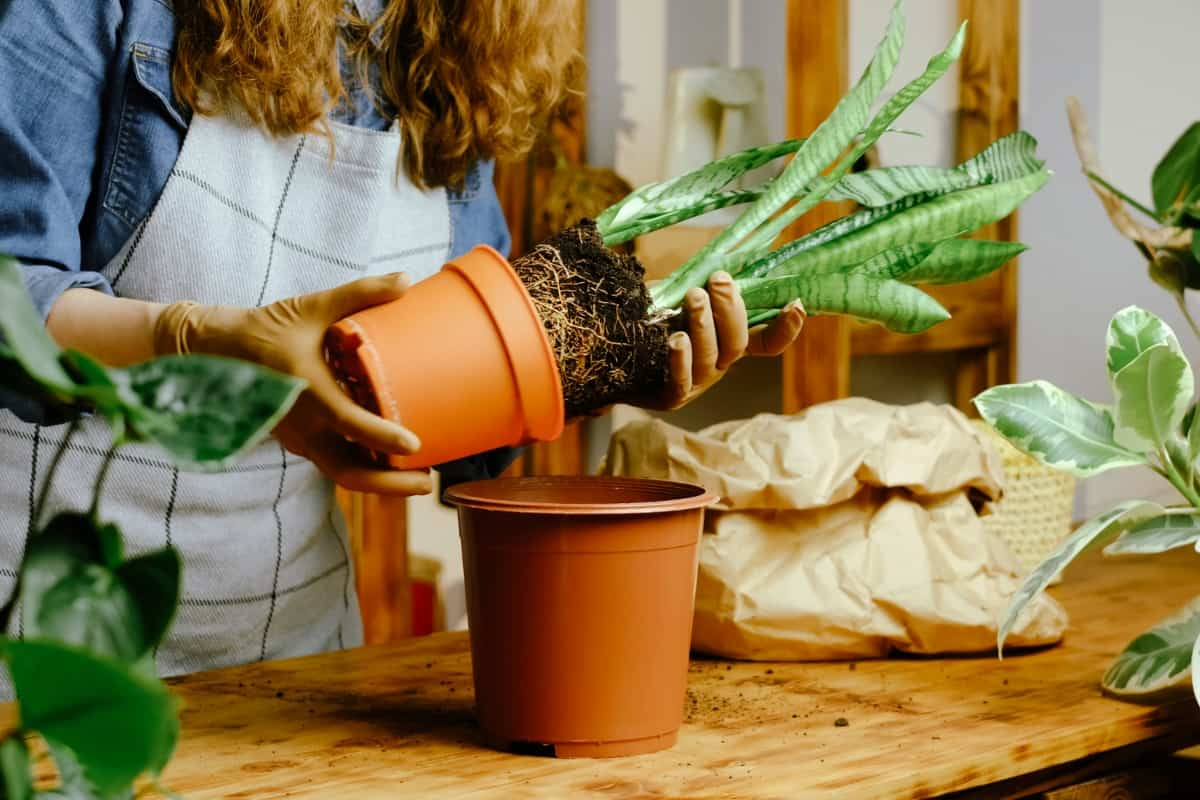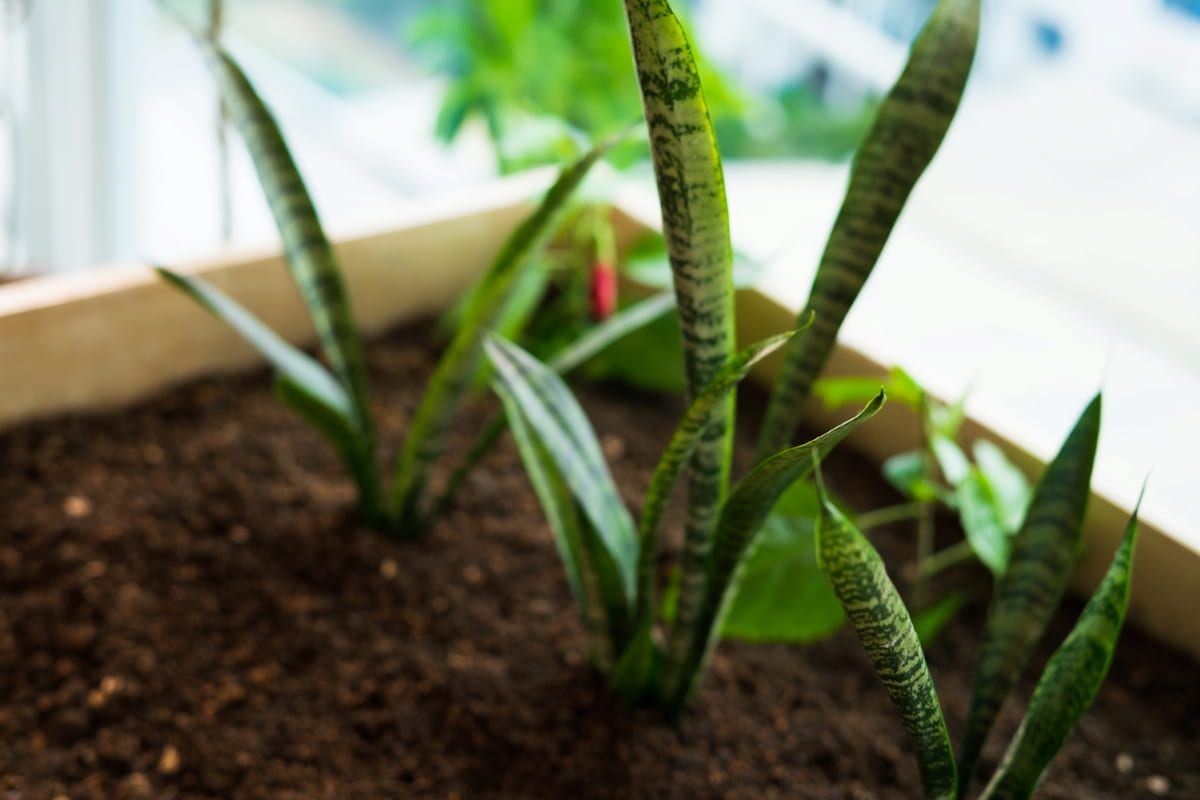With numerous benefits and low maintenance requirements, the Snake plant is an excellent choice for beginners and experienced gardeners. Remember to choose a suitable pot with proper drainage holes, use well-draining soil, water your plant only when necessary, avoid over-fertilizing it, and keep it in bright but indirect light conditions.

How to Plant and Care for Snake Plant
How to Grow Snake Plant Indoors in Low Light
Snake plants are the easiest to grow indoors and thrive in low-light conditions. If you’re someone who doesn’t have a lot of natural light in your home or apartment, then the Snake plant is definitely for you. Finding an area with indirect sunlight when growing a Snake plant indoors is important.
This could be near a window with some sun but not direct sunlight throughout the day. You can also use artificial lighting if needed. When it comes to soil, choose well-draining potting soil mixed with sand or perlite for optimal growth. Avoid using heavy garden soils, as this can lead to root rot. Ensure your pot has drainage holes at the bottom so excess water can escape easily.
Overwatering is one of the most common mistakes beginners make; only water when the top inch of soil feels dry. It’s best to propagate Snake plants during the spring and summer since these seasons promote growth. When planting new cuttings or offsets from an established plant, ensure enough roots are attached before planting them into their new pots.
Choosing the Right Pot and Soil for Snake Plant
Choosing the right pot and soil for a Snake plant is crucial for its growth. The ideal pot should be slightly larger than the plant’s root ball, providing enough room to grow. A container with drainage holes can also prevent waterlogging. Regarding soil, Snake plants prefer well-draining soil that doesn’t hold too much moisture.
It’s best to use regular potting soil and perlite or sand to improve drainage. It’s also important to avoid using heavy clay soils or garden soil as they can retain too much moisture, leading to root rot. Consider the aesthetic appeal of your planter; choose something that complements your home decor while still offering proper growing conditions for your Snake plant.
Watering Frequency for Snake Plant
One of the most important aspects of caring for a Snake plant is getting the watering frequency right. Snake plants tolerate neglect, and over-watering can cause more harm than good. When watering your Snake plant, less is more. You should only water your Snake plant when the soil feels completely dry. It’s also important not to allow your Snake plant to sit in standing water, which can lead to root rot.
Ensure any excess water drains away from the pot promptly after watering. In general, you’ll only need to water your Snake plant once every two weeks or so during its growing season (spring and summer). During cooler months or if your Snake plant is in a low-light environment that isn’t actively growing, you may only need to water once a month or less frequently.
Snake Plant Propagation Techniques
One of the great things about Snake plants is their ability to propagate. This means you can take cuttings from an existing plant and grow new ones without much effort. One common technique for propagating Snake plants is through division, which involves separating a mature plant into smaller sections with roots attached.
This method works well if your original plant has become too large or if you want to create more plants. Another technique is leaf cutting, which involves removing a healthy leaf from the plant and placing it in the soil until the roots develop. While this method takes longer than division, it’s a good option if you can only access one adult Snake plant.
In case you missed it: How to Grow and Care for Japanese Maple: Planting Instructions

Water propagation involves placing cuttings in water until they develop roots before planting them in soil. This method is useful to see root development before potting your new plants. With these simple methods, anyone can successfully propagate their Snake plants and enjoy more of these beautiful and air-purifying houseplants.
Snake Plant Pest Prevention and Treatment
One of the great things about Snake plants is that they are relatively low maintenance and resistant to pests. However, like all houseplants, they can still fall victim to unwanted visitors. Prevention is important when it comes to pest control for Snake plants. Start by keeping your plant healthy and well-watered, as stressed or weakened plants are more susceptible to infestations. Check for any signs of pests regularly, especially if other houseplants carry unwanted guests.
If you do spot pests on your Snake plant, act quickly before they have a chance to spread. Common invaders include spider mites, mealybugs, and scale insects. To remove them, try wiping down the leaves with a damp cloth or spraying with neem oil or insecticidal soap.
For severe infestations, isolating and treating the affected plant more aggressively with pesticides or systemic insecticides (which are absorbed into the plant) may be necessary. Just follow instructions carefully and avoid using harsh chemicals around pets or children.
Snake Plant Sunlight Requirements
Snake plants are low-maintenance houseplants that can thrive in various lighting conditions, making them perfect for beginners. However, while they’re known for their ability to adapt to low-light environments, it’s important to note that they still require some amount of sunlight.
Snake plants should be placed in an area with bright but indirect light. This means placing them near a north or east-facing window where the sun’s rays won’t hit the plant directly. Suppose your Snake plant is not getting enough natural light.
In that case, you may consider supplementing with artificial light sources which provide full-spectrum lighting similar to natural daylight. On the other hand, if your Snake plant is receiving too much sunlight and becoming scorched or browned at its tips, move it further away from the window or add curtains between it and direct sunlight. Finding an ideal location for your Snake plant will depend on several factors, including the brightness of your home’s interior and how close you want it positioned near a window.
Snake Plant Fertilizer Recommendations
When fertilizing your Snake plant, you should keep a few things in mind. First of all, Snake plants don’t require a lot of fertilizer. Over-fertilization can harm the plant rather than help it. If you fertilize your Snake plant, do so sparingly and only during the growing season (spring and summer). Avoid using slow-release fertilizers as they may release nutrients too slowly for the plant’s needs.
Instead, opt for liquid or water-soluble fertilizers that the roots can easily absorb. Be sure not to get fertilizer on the leaves, which can cause burning and damage. Water your Snake plant thoroughly after applying fertilizer to ensure it reaches its roots. Remember that proper care practices like watering frequency and sunlight exposure impact your Snake plant’s health more than fertilization.
Common Issues with Snake Plants and Their Solutions
Snake plants are generally low maintenance and easy to care for, but like any plant, they can encounter some issues. One common issue with Snake plants is overwatering. To prevent this, ensure the soil is well-draining and only water when the top few inches of soil feel dry. Another issue that may arise is pests such as spider mites or mealybugs.
In case you missed it: How to Grow and Care for Bird of Paradise: Planting Instructions

These can be treated by wiping down the leaves with a damp cloth or using an insecticidal soap spray. If your Snake plant’s leaves start to droop or lean over, it could be due to improper lighting. Move your plant closer to a window to get more indirect light. If you notice brown tips on the leaves of your Snake plant, this could indicate low humidity levels in your home. Try misting the leaves regularly or placing a humidifier nearby.
Conclusion
The Snake plant is easy to care for and maintain and has air-purifying properties, making it a great addition to any home or office space. With its striking appearance and low-maintenance needs, it’s no wonder why the Snake plant has become such a popular choice among houseplant enthusiasts.
- Feed Your Flock for Less: Top 10 Tips to Save on Chicken Feed
- Ultimate Guide to Ossabaw Island Hog: Breeding, Raising, Diet, and Care
- Hatching Answers: The Top 10 Reasons Your Chickens Aren’t Laying Eggs
- Eggs and Economics: Breaking Down the Cost of Raising Backyard Chickens
- Defend Your Greens: Proven Methods to Keep Iguanas Out of Your Garden
- Ultimate Guide to Cinnamon Queen Chicken: A Comprehensive Guide for Beginners
- Ultimate Guide to California Tan Chicken: Breeding, Raising, Diet, Egg-Production and Care
- Ultimate Guide to Marsh Daisy Chicken: Breeding, Raising, Diet, and Care
- 10 Types of Chicken Farming Businesses You Can Start for Profits